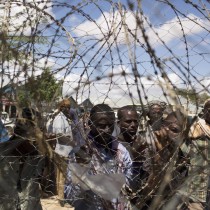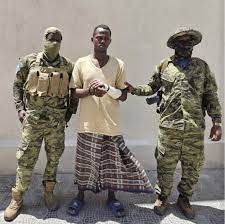Bill Frelick
Director, Refugee ProgramBillFrelick
Hot, dusty wind has constantly passed through the thatch and thorn of Kenya's Dadaab refugee camps since they opened in the early 1990s.
In May, however, a new wind created a chill among the estimated 340,000 mostly Somali refugees living here when President Uhuru Kenyatta declared thatDadaab would be closed by the end of 2016.
After the announcement, Kenyan authorities, together with officials from the United Nations High Commissioner for Refugees (UNHCR), stepped up a program to identify and process refugees willing to go back to Somalia.
Refugees opting for "voluntary repatriation” were promised a cash grant of $200 per person upon leaving and another $200 upon arrival, as well as utensils and other household items and a promise of six months of food assistance—though it is unclear that continuing support is really occurring. Those who refused were given no assurances that they would be allowed to stay.
A Human Rights Watch (HRW) team was in Dadaab from August 17-24 interviewing refugees about the nightmare they have endured for the past four months
and
the anxiety they are now
experiencing
about the four months to come. Some have agreed to return, others have said they want to stay, but all express the same fear: "What happens if we don’t accept the money and assistance to repatriate now? Will we be loaded onto trucks and forced back with nothing later in the year?”
No official has assured any of the people we interviewed that they will not be forced back if they do not agree to go now.
Conditions in
Somalia
do
not appear conducive to refugees returning. The U.S. Agency for International Development’s July 2016 assessment of conditions in
Somalia
said
that
malnutrition rates in the Horn of Africa country remain among the highest in the world and recorded 10,000 cholera cases in the first six months of 2016.UNHCR’s latest
assessment
of conditions in southern/central Somalia in May found: "Civilians continue to be severely affected by the conflict, with reports of civilians being killed and injured in
conflict-related violence, widespread sexual and gender-based violence against women and children, forced recruitment of children, and large-scale displacement.”
At the moment, it is not even
clear
whether local Somali factions will allow
returns
to and through their areas of control.
In 2013, Kenya, Somalia, and UNHCR signed a Tripartite Agreement—set to expire in November—that outlined the standards for voluntary repatriation of Somali refugees. In June,they
reiterated
their commitment to work within the framework of that agreement, yet also noted the "prospect”
of
reducing the Dadaab refugee population by 150,000by the end of 2016.
The communique of the June meeting said nothing about the fate of the other estimated 190,000 refugees in the camps. UNHCR’s silence, combined with Kenyan government statements thatDadaab will be
closed
by the end of November—repeated daily in radio broadcasts here—is why so many of the Somali refugees we have talked to feel that they have no choice but to leave.
The refugees’ fears are reinforced by their memories of the Kenyan
government’s
previous heavy-handed
efforts
to coerce Somalis to go home, includingOperation Usalama
Watch
in 2014, which featured harassment, arbitrary detention, forced relocation to refugee camps and summary deportations.
How many of
the
more than 20,000Somali refugees who have "voluntarily” returned are now displaced internally in unsustainable and unsafe areas of Somalia because they thought if they didn’t "choose” to go with money and assistance, they would be dumped there with nothing in the next few months? How many of the 1,000 people per day
the Kenyan government is now sending back will be heading into danger?
If they truly care about being respectful of refugee wishes, UNHCR, the U.N. agency mandated to protect the world’s refugees, and the Kenyan government
need to acknowledge that refugee repatriation cannot be considered remotely voluntary unless refugees are assured that an option to stay in dignity actually exists.
Laetitia Bader
Researcher
Human Rights Watch
baderl@hrw.org
Skype: leti.b
Kenya Mobile: +254 700 241 854
Kenya Office: +254 730 646 104




 0
0 













Somali Refugees Left in Kenya's Dadaab Face Dangerous Choices
Bill Frelick Director, Refugee ProgramBillFrelick Hot, dusty wind has constantly passed through the thatch and thorn of Kenya's Dadaab refugee camps since they opened in the early 1990s. In May, however, a new wind created a chill among t